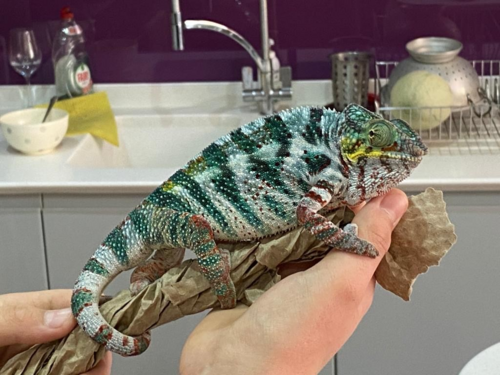ChammyMum
New Member
Hi, new to this and to being a proud owner of a 10 month old panther chameleon (Nosy Faly). He's beautiful and it's a joint purchase with my 15 year old son who already has a decent collection of reptiles. Anyway, we just had a few questions about the settling in behaviour. We bought him (Skittles) home on Saturday and my son had a brief handle before putting him in his new home. He didn't do an awful lot on Saturday but did seem quite edgy if we got close to the glass so left him alone. We put some black cloth down one side of the tank yesterday morning, the back and other side are against a wall so it's only the glass doors that you can see him through. Since then he's been on the move almost constantly. He's got lots of branches and seems to move from being in his basking spot under the lamp to moving all the way down to the bottom and back up again, sometimes via the opposite end of the tank. He does stop for a little while at each place and moves very slowly and cautiously. We haven't seem him leaf walk.
It's a much larger tank than he had at the shop but we have the heat and UV lamps and thermostats and the temp is between 25 and 30 during the day and son sprays quite regularly for the humidity. Skittles gets quite riled when he does that - bulks up, colour changes to being more bright but that's all we do as we don't want to stress him more than necessary.
So the main questions here are:
Any advice for these first couple of weeks would be much appreciated!
It's a much larger tank than he had at the shop but we have the heat and UV lamps and thermostats and the temp is between 25 and 30 during the day and son sprays quite regularly for the humidity. Skittles gets quite riled when he does that - bulks up, colour changes to being more bright but that's all we do as we don't want to stress him more than necessary.
So the main questions here are:
- is it normal for them to be so 'active' while they're settling in? We're hoping he's just exploring. He's settled in the same spot the last two nights to sleep so is that a good sign?
- The colouring we believe goes brighter when they're stressed or anxious? I've attached two photos - one is when we first got him home and the second was yesterday afternoon in the tank. Reckon the colouring says it all about his mood!
- He's not eaten yet but there are a couple of locusts in the tank if he wants to (hoping he doesn't take too long as they're eating some of the plants!) but understand this is normal. Would it be Ok to try and hand feed tomorrow to help him become accustomed to us?
Any advice for these first couple of weeks would be much appreciated!






